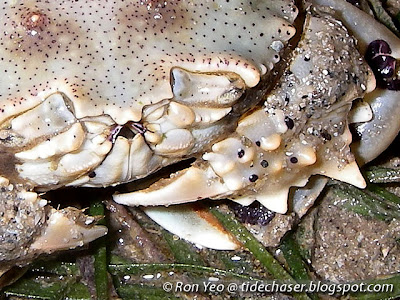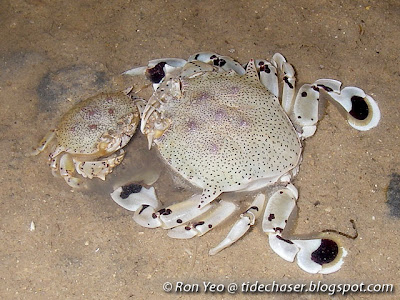Moon crabs (phylum Arthropoda, subphylum Crustacea, class Malacostraca, order Decapoda, suborder Pleocyemata, infraorder Brachyura, superfamily Calappoidea, family Matutidae) are mostly nocturnal, and got their common name from their typically pale round carapace. They are usually found on sandy substrates.

Moon crabs usually have a long spine on each side of the carapace, and all their legs are distinctly flattened laterally into paddle-like structures. Moon crabs are sometimes confused with swimming crabs (family Portunidae), but the latter only have a pair of back legs that are paddle-like.

The paddle-like legs not only allow them to be good swimmers, but excellent burrowers as well. They work like spades and allow the crab to vanish very quickly into the sand. Most moon crabs feed on small invertebrates or scavenges.
Like other true crabs, moon crabs have a broad carapace, and a very short and flattened abdomen which is usually folded underneath the body. They also have five pairs of "legs" (including the clawed arms), and hence they are placed in the order Decapoda ("deca" means "ten", while "poda" means "feet"). The gills are leaf-like - a distinctive characteristic of decapods from the suborder Pleocyemata. And as with other crustaceans from the class Malacostraca, their body comprises three main parts - a head with five segments, a thorax with eight segments, and an abdomen with six segments. The head is fused to the thorax, forming a cephalothorax. They have a tough exoskeleton strengthened with calcium carbonate, and the carapace covers the gills but not the abdomen.

Moon crabs reproduce sexually, and have separate sexes. The females can usually be distinguished from the males by having a broader abdomen. This is an adaptation to allow them to carry the eggs under their abdomen until they hatch. During the breeding season, the larger male can often be seen holding on to a much smaller, immature female, guarding her from other competing suitors. The small female will soon moult and develop into a mature female, and the male will then mate with her.
Here are some of the moon crabs that can be seen Singapore.

The Common Moon Crab (Matuta victor) is one of the most commonly seen moon crabs in Singapore, but is easily confused with another species (see below). It is pale yellow in colour, with numerous fine maroon spots marking its carapace and legs, especially at the joints. It is often found on intertidal sandy shores, and is caught by hand or nets sometimes for consumption.

The Common Moon Crab can be distinguished from other similar-looking local species by the differences in the chelipeds - the ridge on the upper finger of the pincer is made up of a series of small bumps, and there is an obvious oblique ridge on the outer surface which starts near the base of the lower finger and ends with a sharp spine towards the base of the pincer. The maximum carapace width of this species is about 5cm (excluding the spines).

The Spotted Moon Crab (Ashtoret lunaris) is usually found on sandy shores near coral reefs or in seagrass meadows. It can be distinguished from the previous species by the ridge on the upper finger of the pincer, which is complete and not made up of small bumps. Also, the outer surface of the pincer is marked by a series of sharp spines, unlike the previous species which only has a spine towards the end of an oblique ridge.

The carapace of the Spotted Moon Crab is marked with numerous fine maroon spots, much like the carapace of the previous species. However, the spots on the legs are relatively bigger, with some of the spots connected, forming black or maroon patches. The spots on the males tend to be dark maroon or black, while the ones on the females and immatures tend to be maroon. The maximum carapace width of this species is about 5cm (excluding the spines).

The Flower Moon Crab (Matuta planipes) is less commonly seen compared to the previous two species. It is usually found on sandy shores with fine sand, and can be easily distinguished from the other local species by the net-like patterns on the back of the carapace. The carapace can reach a maximum width of about 6cm, excluding the spines.
References

Moon crabs usually have a long spine on each side of the carapace, and all their legs are distinctly flattened laterally into paddle-like structures. Moon crabs are sometimes confused with swimming crabs (family Portunidae), but the latter only have a pair of back legs that are paddle-like.

The paddle-like legs not only allow them to be good swimmers, but excellent burrowers as well. They work like spades and allow the crab to vanish very quickly into the sand. Most moon crabs feed on small invertebrates or scavenges.
Like other true crabs, moon crabs have a broad carapace, and a very short and flattened abdomen which is usually folded underneath the body. They also have five pairs of "legs" (including the clawed arms), and hence they are placed in the order Decapoda ("deca" means "ten", while "poda" means "feet"). The gills are leaf-like - a distinctive characteristic of decapods from the suborder Pleocyemata. And as with other crustaceans from the class Malacostraca, their body comprises three main parts - a head with five segments, a thorax with eight segments, and an abdomen with six segments. The head is fused to the thorax, forming a cephalothorax. They have a tough exoskeleton strengthened with calcium carbonate, and the carapace covers the gills but not the abdomen.

Moon crabs reproduce sexually, and have separate sexes. The females can usually be distinguished from the males by having a broader abdomen. This is an adaptation to allow them to carry the eggs under their abdomen until they hatch. During the breeding season, the larger male can often be seen holding on to a much smaller, immature female, guarding her from other competing suitors. The small female will soon moult and develop into a mature female, and the male will then mate with her.
Here are some of the moon crabs that can be seen Singapore.

The Common Moon Crab (Matuta victor) is one of the most commonly seen moon crabs in Singapore, but is easily confused with another species (see below). It is pale yellow in colour, with numerous fine maroon spots marking its carapace and legs, especially at the joints. It is often found on intertidal sandy shores, and is caught by hand or nets sometimes for consumption.

The Common Moon Crab can be distinguished from other similar-looking local species by the differences in the chelipeds - the ridge on the upper finger of the pincer is made up of a series of small bumps, and there is an obvious oblique ridge on the outer surface which starts near the base of the lower finger and ends with a sharp spine towards the base of the pincer. The maximum carapace width of this species is about 5cm (excluding the spines).

The Spotted Moon Crab (Ashtoret lunaris) is usually found on sandy shores near coral reefs or in seagrass meadows. It can be distinguished from the previous species by the ridge on the upper finger of the pincer, which is complete and not made up of small bumps. Also, the outer surface of the pincer is marked by a series of sharp spines, unlike the previous species which only has a spine towards the end of an oblique ridge.

The carapace of the Spotted Moon Crab is marked with numerous fine maroon spots, much like the carapace of the previous species. However, the spots on the legs are relatively bigger, with some of the spots connected, forming black or maroon patches. The spots on the males tend to be dark maroon or black, while the ones on the females and immatures tend to be maroon. The maximum carapace width of this species is about 5cm (excluding the spines).

The Flower Moon Crab (Matuta planipes) is less commonly seen compared to the previous two species. It is usually found on sandy shores with fine sand, and can be easily distinguished from the other local species by the net-like patterns on the back of the carapace. The carapace can reach a maximum width of about 6cm, excluding the spines.
References
- Carpenter, K. E. & V. H. Niem (eds), 1998-2001. FAO species identification guide for fishery purposes. The living marine resources of the Western Central Pacific. Volumes 1 to 6. FAO, Rome. pp. 1-4218.
- De Grave, S., N. D. Pentcheff , S. T. Ahyong, T.-Y. Chan, K. A. Crandall, P. C. Dworschak, D. L. Felder, R. M. Feldmann, C. H. J. M. Fransen, L. Y. D. Goulding, R. Lemaitre, M. E. Y. Low, J. W. Martin, P. K. L. Ng, C. E. Schweitzer, S. H. Tan, D. Tshudy & R. Wetzer. 2009. A classification of living and fossil genera of decapod crustaceans. The Raffles Bulletin of Zoology, supplement 21, pp. 1-109.
- Debelius, H. 1999. Crustacea - Guide of the world. IKAN, Frankfurt. 321pp.
- ETI BioInformatics. 2012. Marine species identification portal. Retrieved Jul 8, 2013, from http://species-identification.org.
- Ng, P. K. L., S. S. L. Lim, L. K. Wang & L. W. H. Tan. 2007. Private lives: An exposé of Singapore's shores. The Raffles Museum of Biodiversity Research, Department of Biological Sciences, National University of Singapore. 212 pp.
- Ng, P. K .L., R. T. Corlett & H.T.W. Tan (eds.). 2011. Singapore biodiversity: An encyclopedia of the natural environment and sustainable development. Singapore: Editions Didier Millet. 552 pp.
- World Register of Marine Species. 2012. Retrieved Jun 10, 2013, from http://www.marinespecies.org.

No comments:
Post a Comment